Business Finance: Elements, Analysis, and Recommendations
VerifiedAdded on 2023/01/13
|10
|3276
|60
AI Summary
This report provides an overview of the different elements of business finance, including profit, cash flow, working capital, receivables, payables, and inventory. It analyzes the impact of these elements on cash flow and working capital management. The report also offers recommendations for improving cash flow through effective working capital management. The second part of the report focuses on budgeting methods, including traditional and alternative approaches, such as incremental, zero-based, activity-based, and rolling budgets. It explains the purpose of budgeting and discusses the application of these methods in planning future cost management.
Contribute Materials
Your contribution can guide someone’s learning journey. Share your
documents today.
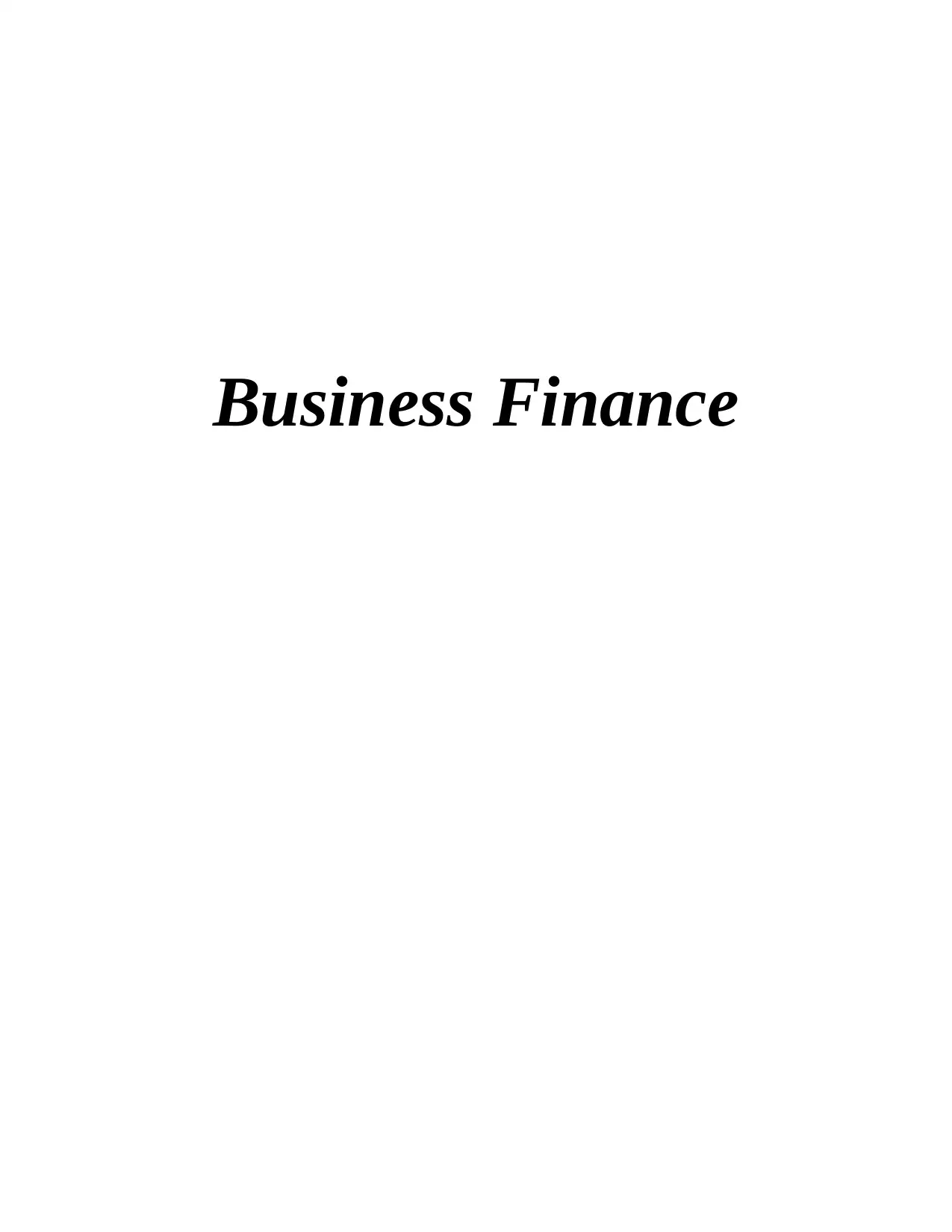
Business Finance
Secure Best Marks with AI Grader
Need help grading? Try our AI Grader for instant feedback on your assignments.
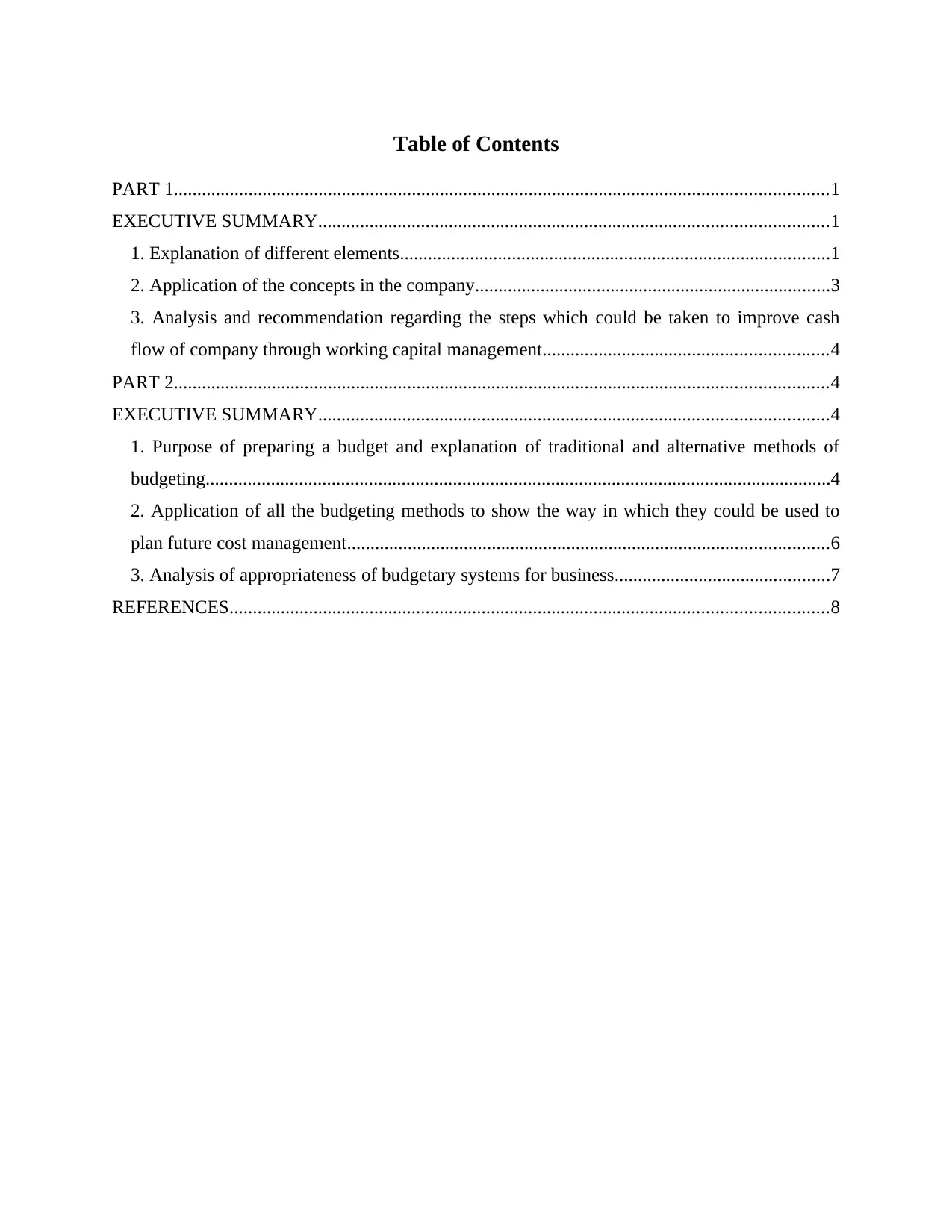
Table of Contents
PART 1............................................................................................................................................1
EXECUTIVE SUMMARY.............................................................................................................1
1. Explanation of different elements............................................................................................1
2. Application of the concepts in the company............................................................................3
3. Analysis and recommendation regarding the steps which could be taken to improve cash
flow of company through working capital management.............................................................4
PART 2............................................................................................................................................4
EXECUTIVE SUMMARY.............................................................................................................4
1. Purpose of preparing a budget and explanation of traditional and alternative methods of
budgeting......................................................................................................................................4
2. Application of all the budgeting methods to show the way in which they could be used to
plan future cost management.......................................................................................................6
3. Analysis of appropriateness of budgetary systems for business..............................................7
REFERENCES................................................................................................................................8
PART 1............................................................................................................................................1
EXECUTIVE SUMMARY.............................................................................................................1
1. Explanation of different elements............................................................................................1
2. Application of the concepts in the company............................................................................3
3. Analysis and recommendation regarding the steps which could be taken to improve cash
flow of company through working capital management.............................................................4
PART 2............................................................................................................................................4
EXECUTIVE SUMMARY.............................................................................................................4
1. Purpose of preparing a budget and explanation of traditional and alternative methods of
budgeting......................................................................................................................................4
2. Application of all the budgeting methods to show the way in which they could be used to
plan future cost management.......................................................................................................6
3. Analysis of appropriateness of budgetary systems for business..............................................7
REFERENCES................................................................................................................................8
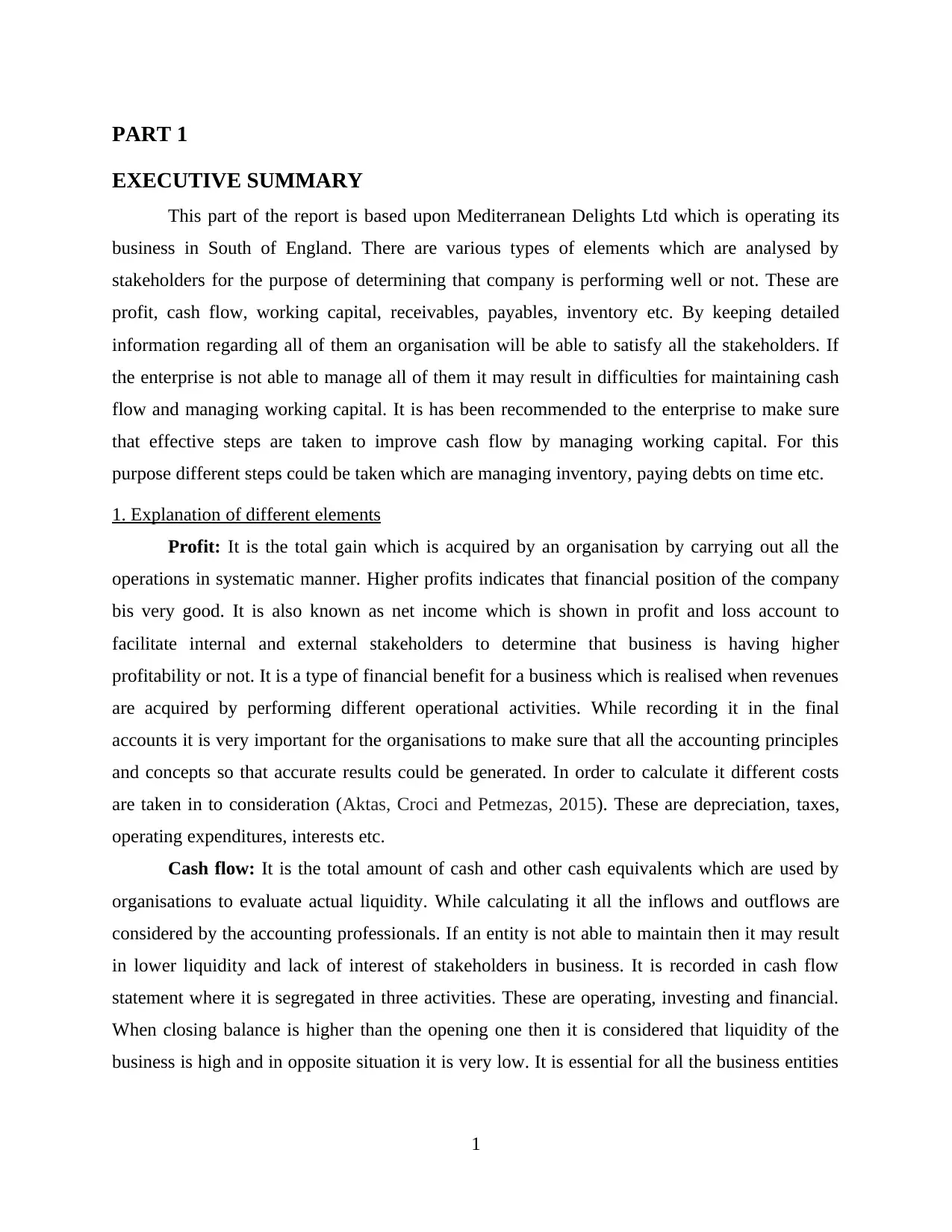
PART 1
EXECUTIVE SUMMARY
This part of the report is based upon Mediterranean Delights Ltd which is operating its
business in South of England. There are various types of elements which are analysed by
stakeholders for the purpose of determining that company is performing well or not. These are
profit, cash flow, working capital, receivables, payables, inventory etc. By keeping detailed
information regarding all of them an organisation will be able to satisfy all the stakeholders. If
the enterprise is not able to manage all of them it may result in difficulties for maintaining cash
flow and managing working capital. It is has been recommended to the enterprise to make sure
that effective steps are taken to improve cash flow by managing working capital. For this
purpose different steps could be taken which are managing inventory, paying debts on time etc.
1. Explanation of different elements
Profit: It is the total gain which is acquired by an organisation by carrying out all the
operations in systematic manner. Higher profits indicates that financial position of the company
bis very good. It is also known as net income which is shown in profit and loss account to
facilitate internal and external stakeholders to determine that business is having higher
profitability or not. It is a type of financial benefit for a business which is realised when revenues
are acquired by performing different operational activities. While recording it in the final
accounts it is very important for the organisations to make sure that all the accounting principles
and concepts so that accurate results could be generated. In order to calculate it different costs
are taken in to consideration (Aktas, Croci and Petmezas, 2015). These are depreciation, taxes,
operating expenditures, interests etc.
Cash flow: It is the total amount of cash and other cash equivalents which are used by
organisations to evaluate actual liquidity. While calculating it all the inflows and outflows are
considered by the accounting professionals. If an entity is not able to maintain then it may result
in lower liquidity and lack of interest of stakeholders in business. It is recorded in cash flow
statement where it is segregated in three activities. These are operating, investing and financial.
When closing balance is higher than the opening one then it is considered that liquidity of the
business is high and in opposite situation it is very low. It is essential for all the business entities
1
EXECUTIVE SUMMARY
This part of the report is based upon Mediterranean Delights Ltd which is operating its
business in South of England. There are various types of elements which are analysed by
stakeholders for the purpose of determining that company is performing well or not. These are
profit, cash flow, working capital, receivables, payables, inventory etc. By keeping detailed
information regarding all of them an organisation will be able to satisfy all the stakeholders. If
the enterprise is not able to manage all of them it may result in difficulties for maintaining cash
flow and managing working capital. It is has been recommended to the enterprise to make sure
that effective steps are taken to improve cash flow by managing working capital. For this
purpose different steps could be taken which are managing inventory, paying debts on time etc.
1. Explanation of different elements
Profit: It is the total gain which is acquired by an organisation by carrying out all the
operations in systematic manner. Higher profits indicates that financial position of the company
bis very good. It is also known as net income which is shown in profit and loss account to
facilitate internal and external stakeholders to determine that business is having higher
profitability or not. It is a type of financial benefit for a business which is realised when revenues
are acquired by performing different operational activities. While recording it in the final
accounts it is very important for the organisations to make sure that all the accounting principles
and concepts so that accurate results could be generated. In order to calculate it different costs
are taken in to consideration (Aktas, Croci and Petmezas, 2015). These are depreciation, taxes,
operating expenditures, interests etc.
Cash flow: It is the total amount of cash and other cash equivalents which are used by
organisations to evaluate actual liquidity. While calculating it all the inflows and outflows are
considered by the accounting professionals. If an entity is not able to maintain then it may result
in lower liquidity and lack of interest of stakeholders in business. It is recorded in cash flow
statement where it is segregated in three activities. These are operating, investing and financial.
When closing balance is higher than the opening one then it is considered that liquidity of the
business is high and in opposite situation it is very low. It is essential for all the business entities
1
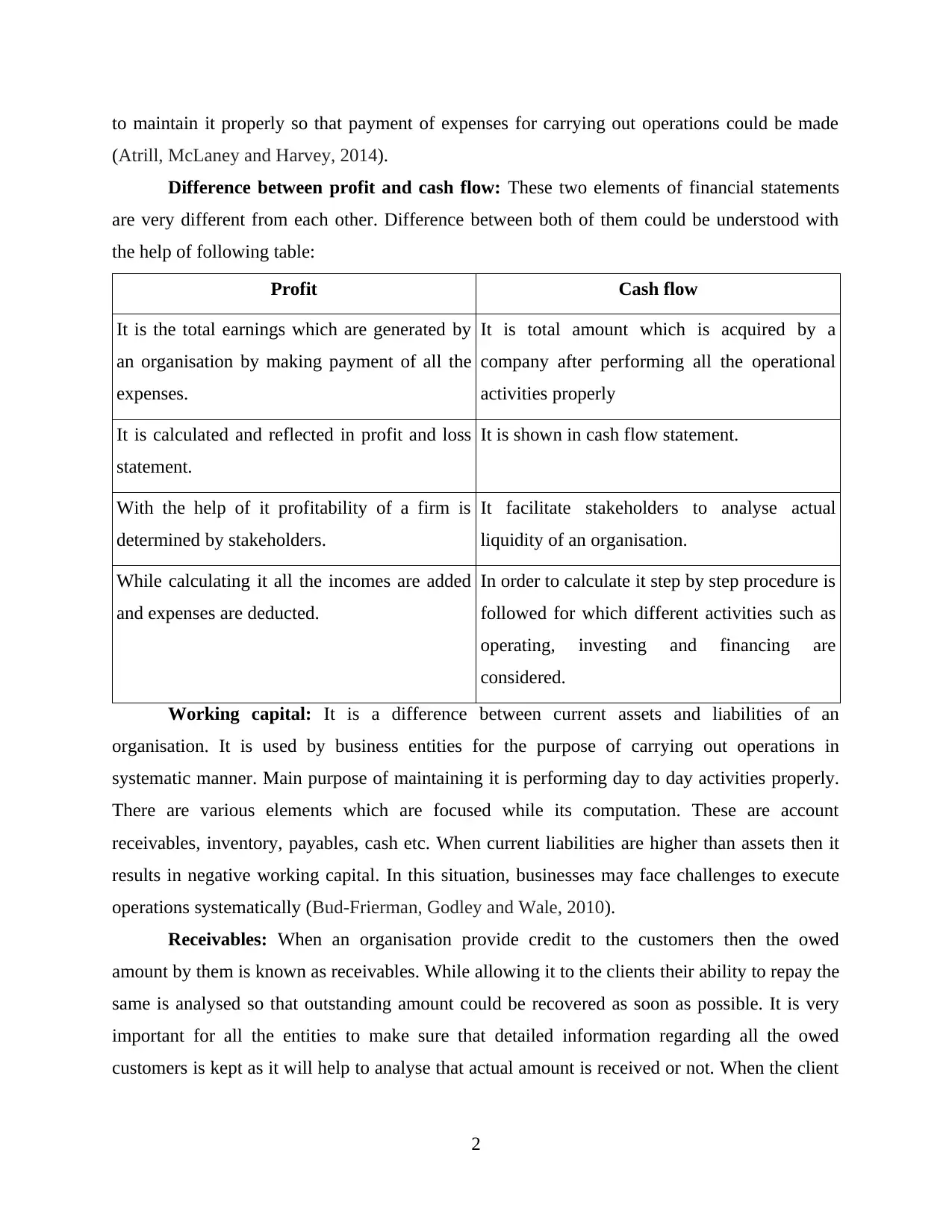
to maintain it properly so that payment of expenses for carrying out operations could be made
(Atrill, McLaney and Harvey, 2014).
Difference between profit and cash flow: These two elements of financial statements
are very different from each other. Difference between both of them could be understood with
the help of following table:
Profit Cash flow
It is the total earnings which are generated by
an organisation by making payment of all the
expenses.
It is total amount which is acquired by a
company after performing all the operational
activities properly
It is calculated and reflected in profit and loss
statement.
It is shown in cash flow statement.
With the help of it profitability of a firm is
determined by stakeholders.
It facilitate stakeholders to analyse actual
liquidity of an organisation.
While calculating it all the incomes are added
and expenses are deducted.
In order to calculate it step by step procedure is
followed for which different activities such as
operating, investing and financing are
considered.
Working capital: It is a difference between current assets and liabilities of an
organisation. It is used by business entities for the purpose of carrying out operations in
systematic manner. Main purpose of maintaining it is performing day to day activities properly.
There are various elements which are focused while its computation. These are account
receivables, inventory, payables, cash etc. When current liabilities are higher than assets then it
results in negative working capital. In this situation, businesses may face challenges to execute
operations systematically (Bud-Frierman, Godley and Wale, 2010).
Receivables: When an organisation provide credit to the customers then the owed
amount by them is known as receivables. While allowing it to the clients their ability to repay the
same is analysed so that outstanding amount could be recovered as soon as possible. It is very
important for all the entities to make sure that detailed information regarding all the owed
customers is kept as it will help to analyse that actual amount is received or not. When the client
2
(Atrill, McLaney and Harvey, 2014).
Difference between profit and cash flow: These two elements of financial statements
are very different from each other. Difference between both of them could be understood with
the help of following table:
Profit Cash flow
It is the total earnings which are generated by
an organisation by making payment of all the
expenses.
It is total amount which is acquired by a
company after performing all the operational
activities properly
It is calculated and reflected in profit and loss
statement.
It is shown in cash flow statement.
With the help of it profitability of a firm is
determined by stakeholders.
It facilitate stakeholders to analyse actual
liquidity of an organisation.
While calculating it all the incomes are added
and expenses are deducted.
In order to calculate it step by step procedure is
followed for which different activities such as
operating, investing and financing are
considered.
Working capital: It is a difference between current assets and liabilities of an
organisation. It is used by business entities for the purpose of carrying out operations in
systematic manner. Main purpose of maintaining it is performing day to day activities properly.
There are various elements which are focused while its computation. These are account
receivables, inventory, payables, cash etc. When current liabilities are higher than assets then it
results in negative working capital. In this situation, businesses may face challenges to execute
operations systematically (Bud-Frierman, Godley and Wale, 2010).
Receivables: When an organisation provide credit to the customers then the owed
amount by them is known as receivables. While allowing it to the clients their ability to repay the
same is analysed so that outstanding amount could be recovered as soon as possible. It is very
important for all the entities to make sure that detailed information regarding all the owed
customers is kept as it will help to analyse that actual amount is received or not. When the client
2
Secure Best Marks with AI Grader
Need help grading? Try our AI Grader for instant feedback on your assignments.
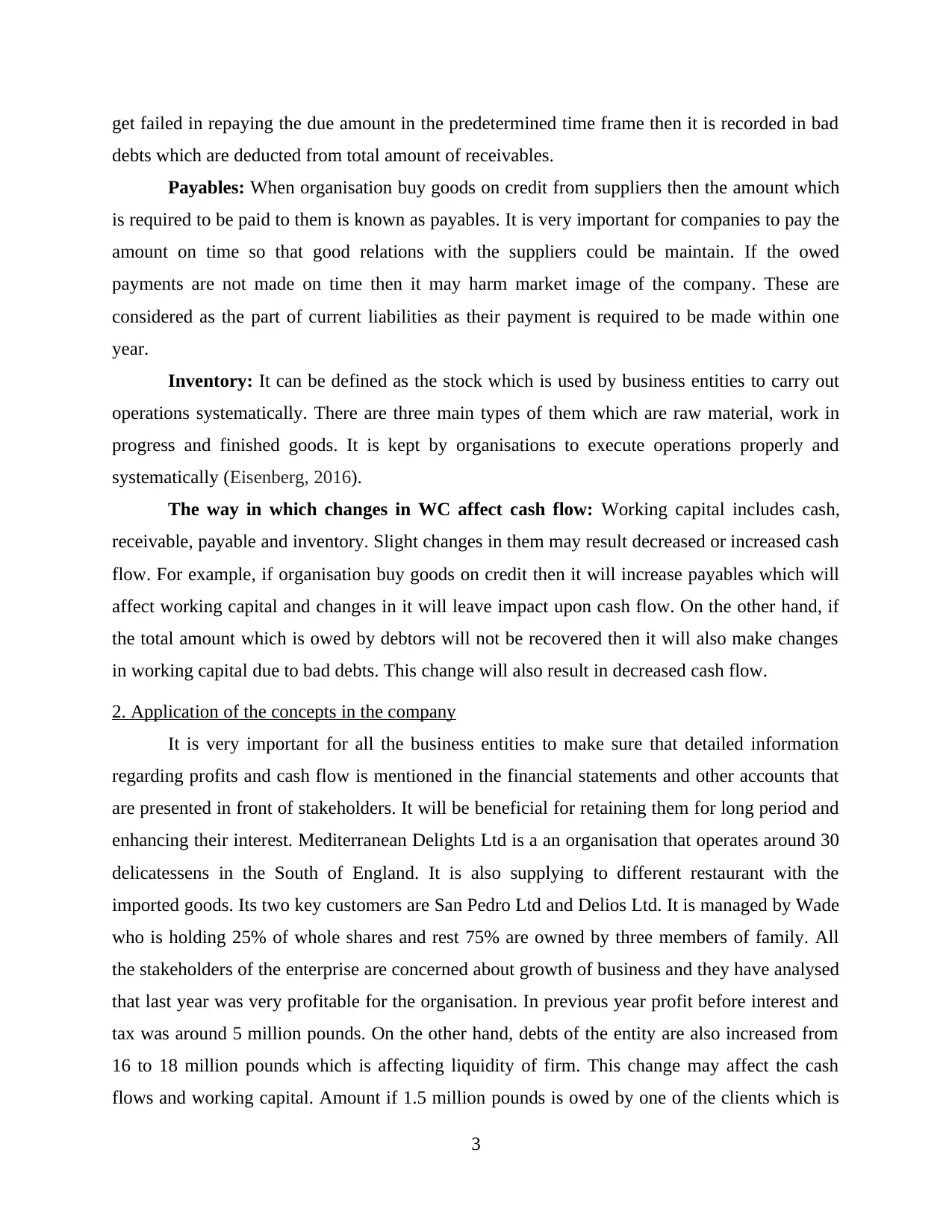
get failed in repaying the due amount in the predetermined time frame then it is recorded in bad
debts which are deducted from total amount of receivables.
Payables: When organisation buy goods on credit from suppliers then the amount which
is required to be paid to them is known as payables. It is very important for companies to pay the
amount on time so that good relations with the suppliers could be maintain. If the owed
payments are not made on time then it may harm market image of the company. These are
considered as the part of current liabilities as their payment is required to be made within one
year.
Inventory: It can be defined as the stock which is used by business entities to carry out
operations systematically. There are three main types of them which are raw material, work in
progress and finished goods. It is kept by organisations to execute operations properly and
systematically (Eisenberg, 2016).
The way in which changes in WC affect cash flow: Working capital includes cash,
receivable, payable and inventory. Slight changes in them may result decreased or increased cash
flow. For example, if organisation buy goods on credit then it will increase payables which will
affect working capital and changes in it will leave impact upon cash flow. On the other hand, if
the total amount which is owed by debtors will not be recovered then it will also make changes
in working capital due to bad debts. This change will also result in decreased cash flow.
2. Application of the concepts in the company
It is very important for all the business entities to make sure that detailed information
regarding profits and cash flow is mentioned in the financial statements and other accounts that
are presented in front of stakeholders. It will be beneficial for retaining them for long period and
enhancing their interest. Mediterranean Delights Ltd is a an organisation that operates around 30
delicatessens in the South of England. It is also supplying to different restaurant with the
imported goods. Its two key customers are San Pedro Ltd and Delios Ltd. It is managed by Wade
who is holding 25% of whole shares and rest 75% are owned by three members of family. All
the stakeholders of the enterprise are concerned about growth of business and they have analysed
that last year was very profitable for the organisation. In previous year profit before interest and
tax was around 5 million pounds. On the other hand, debts of the entity are also increased from
16 to 18 million pounds which is affecting liquidity of firm. This change may affect the cash
flows and working capital. Amount if 1.5 million pounds is owed by one of the clients which is
3
debts which are deducted from total amount of receivables.
Payables: When organisation buy goods on credit from suppliers then the amount which
is required to be paid to them is known as payables. It is very important for companies to pay the
amount on time so that good relations with the suppliers could be maintain. If the owed
payments are not made on time then it may harm market image of the company. These are
considered as the part of current liabilities as their payment is required to be made within one
year.
Inventory: It can be defined as the stock which is used by business entities to carry out
operations systematically. There are three main types of them which are raw material, work in
progress and finished goods. It is kept by organisations to execute operations properly and
systematically (Eisenberg, 2016).
The way in which changes in WC affect cash flow: Working capital includes cash,
receivable, payable and inventory. Slight changes in them may result decreased or increased cash
flow. For example, if organisation buy goods on credit then it will increase payables which will
affect working capital and changes in it will leave impact upon cash flow. On the other hand, if
the total amount which is owed by debtors will not be recovered then it will also make changes
in working capital due to bad debts. This change will also result in decreased cash flow.
2. Application of the concepts in the company
It is very important for all the business entities to make sure that detailed information
regarding profits and cash flow is mentioned in the financial statements and other accounts that
are presented in front of stakeholders. It will be beneficial for retaining them for long period and
enhancing their interest. Mediterranean Delights Ltd is a an organisation that operates around 30
delicatessens in the South of England. It is also supplying to different restaurant with the
imported goods. Its two key customers are San Pedro Ltd and Delios Ltd. It is managed by Wade
who is holding 25% of whole shares and rest 75% are owned by three members of family. All
the stakeholders of the enterprise are concerned about growth of business and they have analysed
that last year was very profitable for the organisation. In previous year profit before interest and
tax was around 5 million pounds. On the other hand, debts of the entity are also increased from
16 to 18 million pounds which is affecting liquidity of firm. This change may affect the cash
flows and working capital. Amount if 1.5 million pounds is owed by one of the clients which is
3
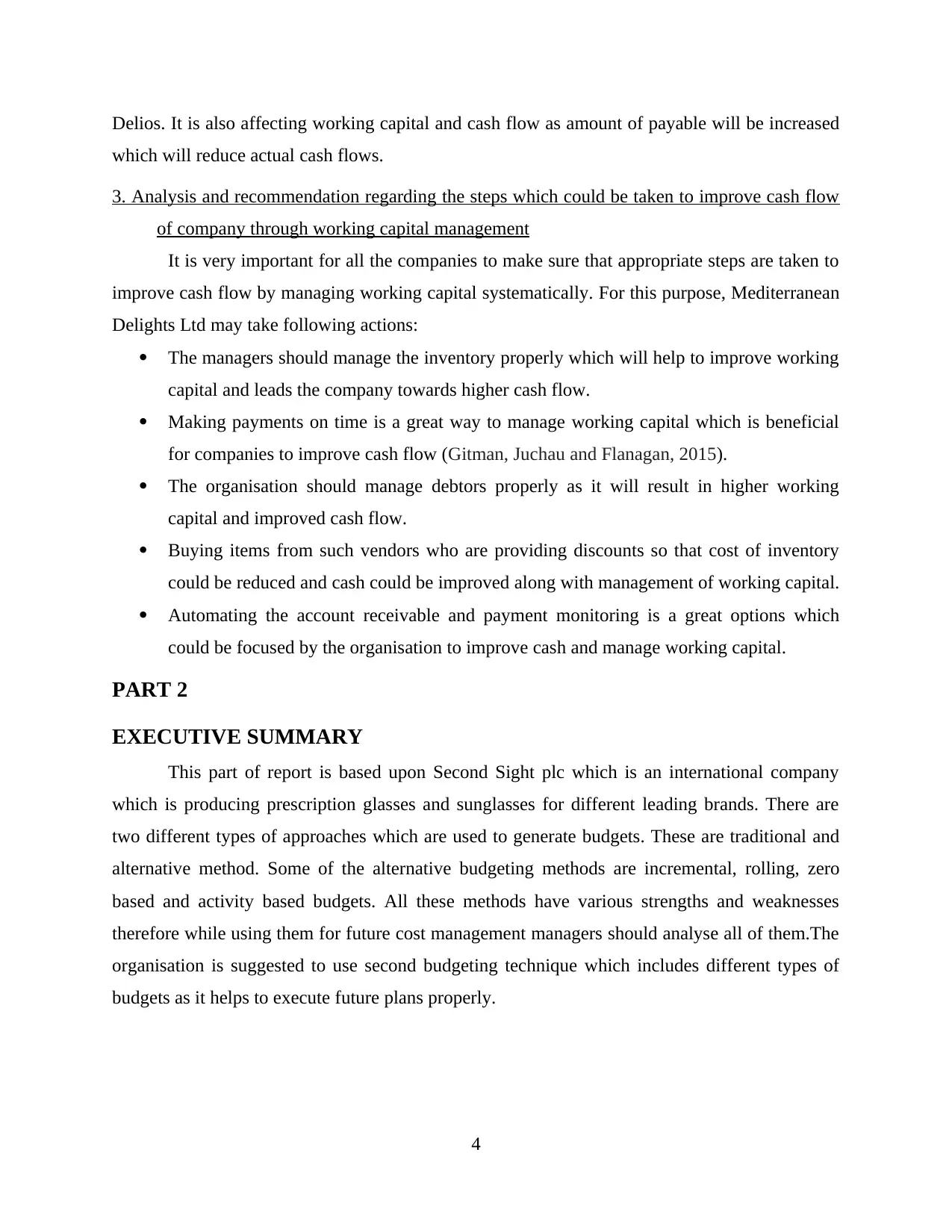
Delios. It is also affecting working capital and cash flow as amount of payable will be increased
which will reduce actual cash flows.
3. Analysis and recommendation regarding the steps which could be taken to improve cash flow
of company through working capital management
It is very important for all the companies to make sure that appropriate steps are taken to
improve cash flow by managing working capital systematically. For this purpose, Mediterranean
Delights Ltd may take following actions:
The managers should manage the inventory properly which will help to improve working
capital and leads the company towards higher cash flow.
Making payments on time is a great way to manage working capital which is beneficial
for companies to improve cash flow (Gitman, Juchau and Flanagan, 2015).
The organisation should manage debtors properly as it will result in higher working
capital and improved cash flow.
Buying items from such vendors who are providing discounts so that cost of inventory
could be reduced and cash could be improved along with management of working capital.
Automating the account receivable and payment monitoring is a great options which
could be focused by the organisation to improve cash and manage working capital.
PART 2
EXECUTIVE SUMMARY
This part of report is based upon Second Sight plc which is an international company
which is producing prescription glasses and sunglasses for different leading brands. There are
two different types of approaches which are used to generate budgets. These are traditional and
alternative method. Some of the alternative budgeting methods are incremental, rolling, zero
based and activity based budgets. All these methods have various strengths and weaknesses
therefore while using them for future cost management managers should analyse all of them.The
organisation is suggested to use second budgeting technique which includes different types of
budgets as it helps to execute future plans properly.
4
which will reduce actual cash flows.
3. Analysis and recommendation regarding the steps which could be taken to improve cash flow
of company through working capital management
It is very important for all the companies to make sure that appropriate steps are taken to
improve cash flow by managing working capital systematically. For this purpose, Mediterranean
Delights Ltd may take following actions:
The managers should manage the inventory properly which will help to improve working
capital and leads the company towards higher cash flow.
Making payments on time is a great way to manage working capital which is beneficial
for companies to improve cash flow (Gitman, Juchau and Flanagan, 2015).
The organisation should manage debtors properly as it will result in higher working
capital and improved cash flow.
Buying items from such vendors who are providing discounts so that cost of inventory
could be reduced and cash could be improved along with management of working capital.
Automating the account receivable and payment monitoring is a great options which
could be focused by the organisation to improve cash and manage working capital.
PART 2
EXECUTIVE SUMMARY
This part of report is based upon Second Sight plc which is an international company
which is producing prescription glasses and sunglasses for different leading brands. There are
two different types of approaches which are used to generate budgets. These are traditional and
alternative method. Some of the alternative budgeting methods are incremental, rolling, zero
based and activity based budgets. All these methods have various strengths and weaknesses
therefore while using them for future cost management managers should analyse all of them.The
organisation is suggested to use second budgeting technique which includes different types of
budgets as it helps to execute future plans properly.
4
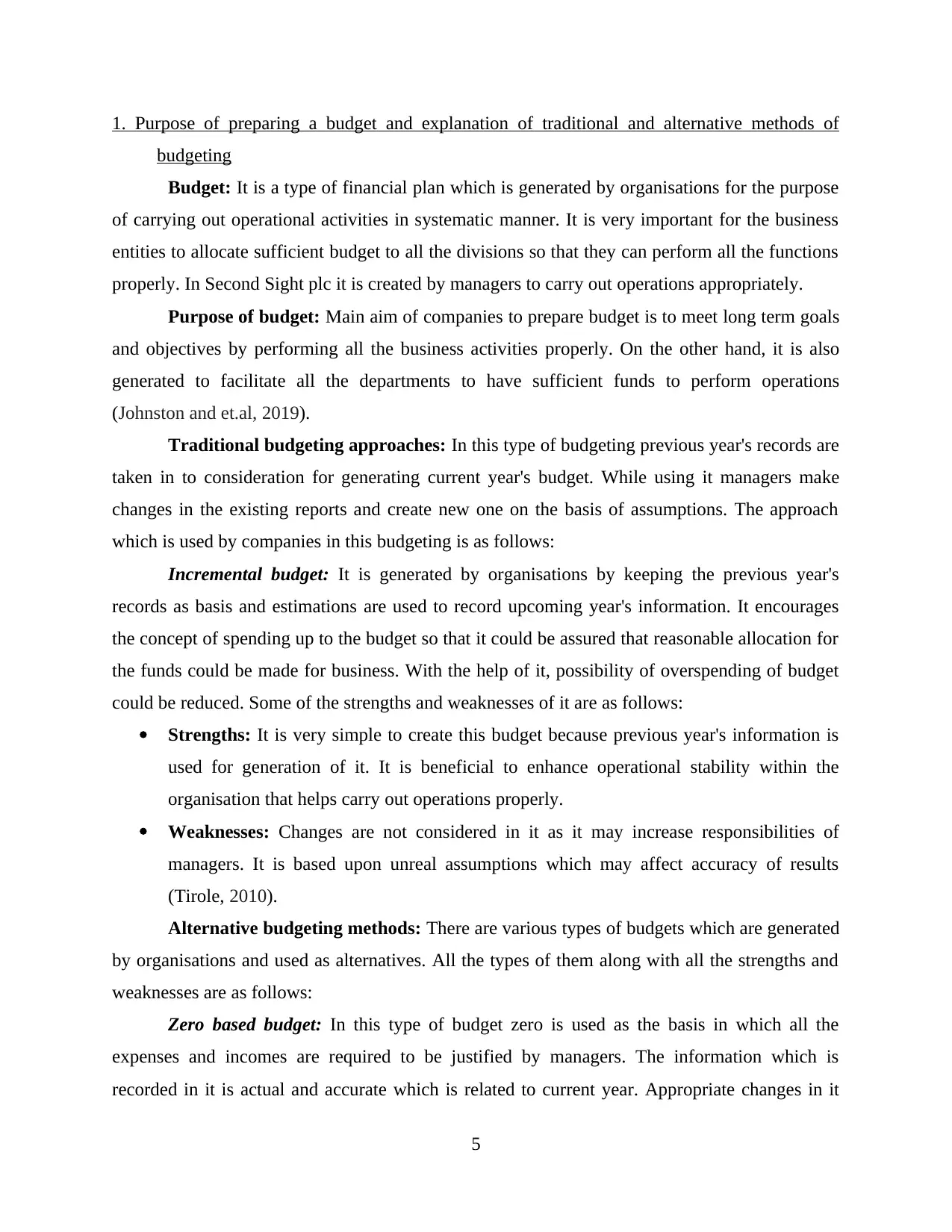
1. Purpose of preparing a budget and explanation of traditional and alternative methods of
budgeting
Budget: It is a type of financial plan which is generated by organisations for the purpose
of carrying out operational activities in systematic manner. It is very important for the business
entities to allocate sufficient budget to all the divisions so that they can perform all the functions
properly. In Second Sight plc it is created by managers to carry out operations appropriately.
Purpose of budget: Main aim of companies to prepare budget is to meet long term goals
and objectives by performing all the business activities properly. On the other hand, it is also
generated to facilitate all the departments to have sufficient funds to perform operations
(Johnston and et.al, 2019).
Traditional budgeting approaches: In this type of budgeting previous year's records are
taken in to consideration for generating current year's budget. While using it managers make
changes in the existing reports and create new one on the basis of assumptions. The approach
which is used by companies in this budgeting is as follows:
Incremental budget: It is generated by organisations by keeping the previous year's
records as basis and estimations are used to record upcoming year's information. It encourages
the concept of spending up to the budget so that it could be assured that reasonable allocation for
the funds could be made for business. With the help of it, possibility of overspending of budget
could be reduced. Some of the strengths and weaknesses of it are as follows:
Strengths: It is very simple to create this budget because previous year's information is
used for generation of it. It is beneficial to enhance operational stability within the
organisation that helps carry out operations properly.
Weaknesses: Changes are not considered in it as it may increase responsibilities of
managers. It is based upon unreal assumptions which may affect accuracy of results
(Tirole, 2010).
Alternative budgeting methods: There are various types of budgets which are generated
by organisations and used as alternatives. All the types of them along with all the strengths and
weaknesses are as follows:
Zero based budget: In this type of budget zero is used as the basis in which all the
expenses and incomes are required to be justified by managers. The information which is
recorded in it is actual and accurate which is related to current year. Appropriate changes in it
5
budgeting
Budget: It is a type of financial plan which is generated by organisations for the purpose
of carrying out operational activities in systematic manner. It is very important for the business
entities to allocate sufficient budget to all the divisions so that they can perform all the functions
properly. In Second Sight plc it is created by managers to carry out operations appropriately.
Purpose of budget: Main aim of companies to prepare budget is to meet long term goals
and objectives by performing all the business activities properly. On the other hand, it is also
generated to facilitate all the departments to have sufficient funds to perform operations
(Johnston and et.al, 2019).
Traditional budgeting approaches: In this type of budgeting previous year's records are
taken in to consideration for generating current year's budget. While using it managers make
changes in the existing reports and create new one on the basis of assumptions. The approach
which is used by companies in this budgeting is as follows:
Incremental budget: It is generated by organisations by keeping the previous year's
records as basis and estimations are used to record upcoming year's information. It encourages
the concept of spending up to the budget so that it could be assured that reasonable allocation for
the funds could be made for business. With the help of it, possibility of overspending of budget
could be reduced. Some of the strengths and weaknesses of it are as follows:
Strengths: It is very simple to create this budget because previous year's information is
used for generation of it. It is beneficial to enhance operational stability within the
organisation that helps carry out operations properly.
Weaknesses: Changes are not considered in it as it may increase responsibilities of
managers. It is based upon unreal assumptions which may affect accuracy of results
(Tirole, 2010).
Alternative budgeting methods: There are various types of budgets which are generated
by organisations and used as alternatives. All the types of them along with all the strengths and
weaknesses are as follows:
Zero based budget: In this type of budget zero is used as the basis in which all the
expenses and incomes are required to be justified by managers. The information which is
recorded in it is actual and accurate which is related to current year. Appropriate changes in it
5
Paraphrase This Document
Need a fresh take? Get an instant paraphrase of this document with our AI Paraphraser
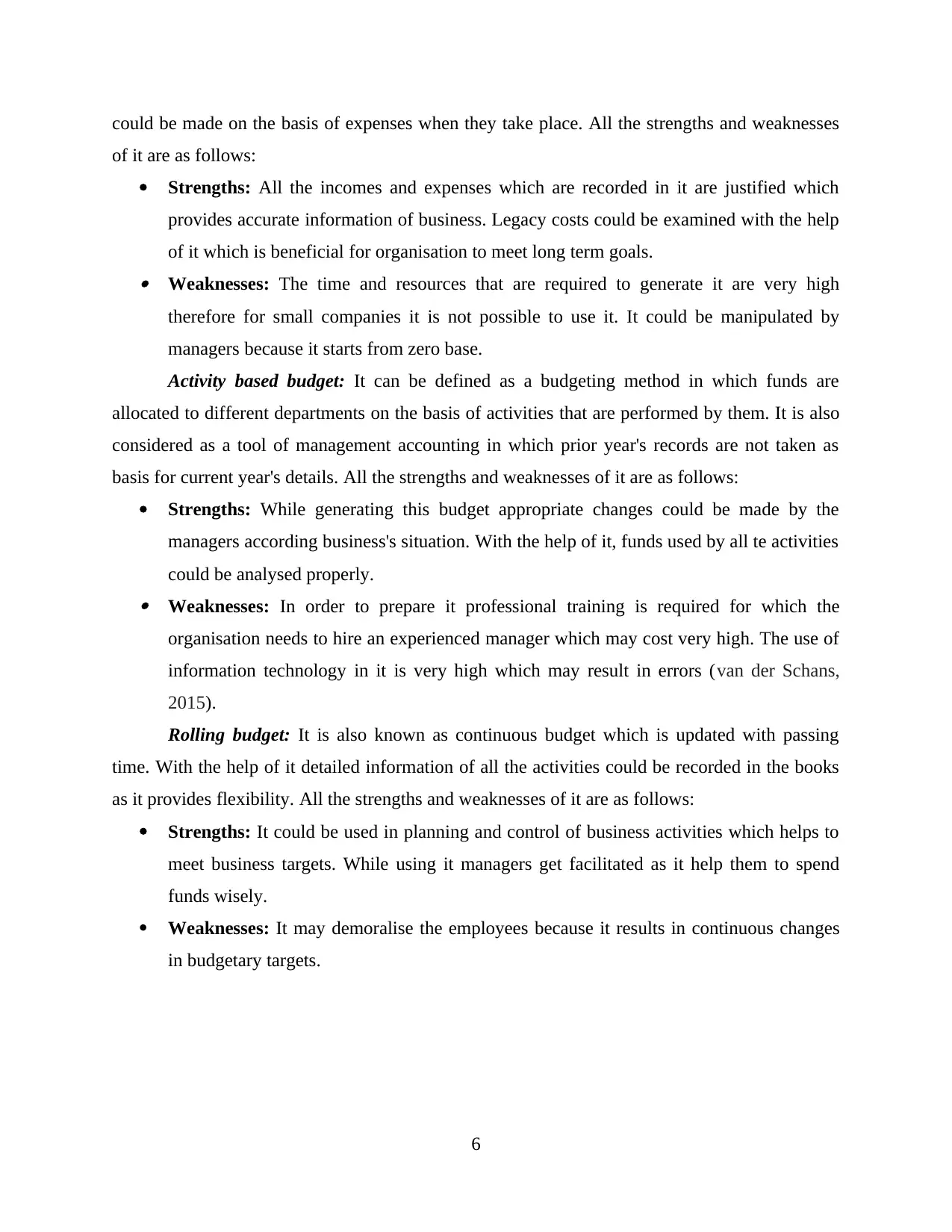
could be made on the basis of expenses when they take place. All the strengths and weaknesses
of it are as follows:
Strengths: All the incomes and expenses which are recorded in it are justified which
provides accurate information of business. Legacy costs could be examined with the help
of it which is beneficial for organisation to meet long term goals. Weaknesses: The time and resources that are required to generate it are very high
therefore for small companies it is not possible to use it. It could be manipulated by
managers because it starts from zero base.
Activity based budget: It can be defined as a budgeting method in which funds are
allocated to different departments on the basis of activities that are performed by them. It is also
considered as a tool of management accounting in which prior year's records are not taken as
basis for current year's details. All the strengths and weaknesses of it are as follows:
Strengths: While generating this budget appropriate changes could be made by the
managers according business's situation. With the help of it, funds used by all te activities
could be analysed properly. Weaknesses: In order to prepare it professional training is required for which the
organisation needs to hire an experienced manager which may cost very high. The use of
information technology in it is very high which may result in errors (van der Schans,
2015).
Rolling budget: It is also known as continuous budget which is updated with passing
time. With the help of it detailed information of all the activities could be recorded in the books
as it provides flexibility. All the strengths and weaknesses of it are as follows:
Strengths: It could be used in planning and control of business activities which helps to
meet business targets. While using it managers get facilitated as it help them to spend
funds wisely.
Weaknesses: It may demoralise the employees because it results in continuous changes
in budgetary targets.
6
of it are as follows:
Strengths: All the incomes and expenses which are recorded in it are justified which
provides accurate information of business. Legacy costs could be examined with the help
of it which is beneficial for organisation to meet long term goals. Weaknesses: The time and resources that are required to generate it are very high
therefore for small companies it is not possible to use it. It could be manipulated by
managers because it starts from zero base.
Activity based budget: It can be defined as a budgeting method in which funds are
allocated to different departments on the basis of activities that are performed by them. It is also
considered as a tool of management accounting in which prior year's records are not taken as
basis for current year's details. All the strengths and weaknesses of it are as follows:
Strengths: While generating this budget appropriate changes could be made by the
managers according business's situation. With the help of it, funds used by all te activities
could be analysed properly. Weaknesses: In order to prepare it professional training is required for which the
organisation needs to hire an experienced manager which may cost very high. The use of
information technology in it is very high which may result in errors (van der Schans,
2015).
Rolling budget: It is also known as continuous budget which is updated with passing
time. With the help of it detailed information of all the activities could be recorded in the books
as it provides flexibility. All the strengths and weaknesses of it are as follows:
Strengths: It could be used in planning and control of business activities which helps to
meet business targets. While using it managers get facilitated as it help them to spend
funds wisely.
Weaknesses: It may demoralise the employees because it results in continuous changes
in budgetary targets.
6
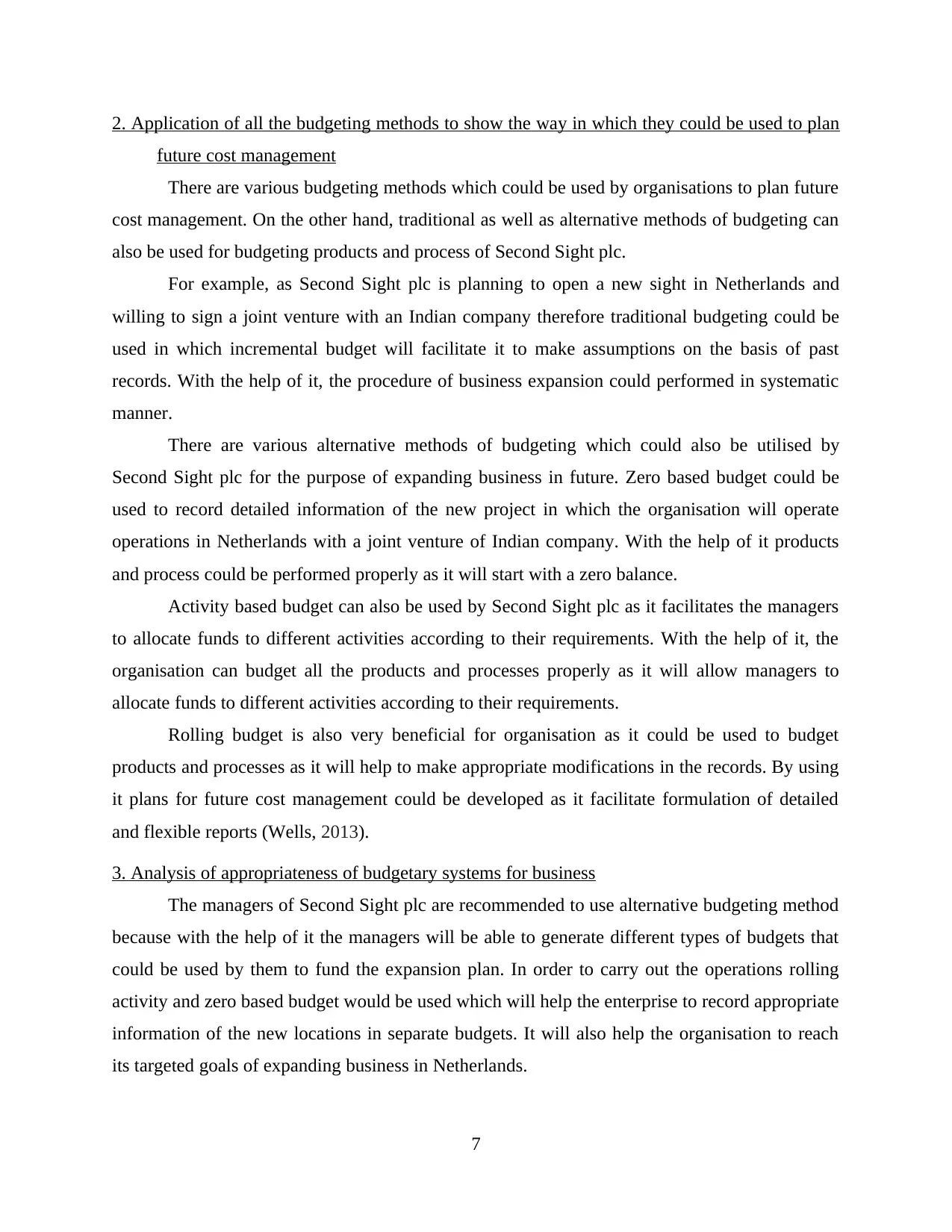
2. Application of all the budgeting methods to show the way in which they could be used to plan
future cost management
There are various budgeting methods which could be used by organisations to plan future
cost management. On the other hand, traditional as well as alternative methods of budgeting can
also be used for budgeting products and process of Second Sight plc.
For example, as Second Sight plc is planning to open a new sight in Netherlands and
willing to sign a joint venture with an Indian company therefore traditional budgeting could be
used in which incremental budget will facilitate it to make assumptions on the basis of past
records. With the help of it, the procedure of business expansion could performed in systematic
manner.
There are various alternative methods of budgeting which could also be utilised by
Second Sight plc for the purpose of expanding business in future. Zero based budget could be
used to record detailed information of the new project in which the organisation will operate
operations in Netherlands with a joint venture of Indian company. With the help of it products
and process could be performed properly as it will start with a zero balance.
Activity based budget can also be used by Second Sight plc as it facilitates the managers
to allocate funds to different activities according to their requirements. With the help of it, the
organisation can budget all the products and processes properly as it will allow managers to
allocate funds to different activities according to their requirements.
Rolling budget is also very beneficial for organisation as it could be used to budget
products and processes as it will help to make appropriate modifications in the records. By using
it plans for future cost management could be developed as it facilitate formulation of detailed
and flexible reports (Wells, 2013).
3. Analysis of appropriateness of budgetary systems for business
The managers of Second Sight plc are recommended to use alternative budgeting method
because with the help of it the managers will be able to generate different types of budgets that
could be used by them to fund the expansion plan. In order to carry out the operations rolling
activity and zero based budget would be used which will help the enterprise to record appropriate
information of the new locations in separate budgets. It will also help the organisation to reach
its targeted goals of expanding business in Netherlands.
7
future cost management
There are various budgeting methods which could be used by organisations to plan future
cost management. On the other hand, traditional as well as alternative methods of budgeting can
also be used for budgeting products and process of Second Sight plc.
For example, as Second Sight plc is planning to open a new sight in Netherlands and
willing to sign a joint venture with an Indian company therefore traditional budgeting could be
used in which incremental budget will facilitate it to make assumptions on the basis of past
records. With the help of it, the procedure of business expansion could performed in systematic
manner.
There are various alternative methods of budgeting which could also be utilised by
Second Sight plc for the purpose of expanding business in future. Zero based budget could be
used to record detailed information of the new project in which the organisation will operate
operations in Netherlands with a joint venture of Indian company. With the help of it products
and process could be performed properly as it will start with a zero balance.
Activity based budget can also be used by Second Sight plc as it facilitates the managers
to allocate funds to different activities according to their requirements. With the help of it, the
organisation can budget all the products and processes properly as it will allow managers to
allocate funds to different activities according to their requirements.
Rolling budget is also very beneficial for organisation as it could be used to budget
products and processes as it will help to make appropriate modifications in the records. By using
it plans for future cost management could be developed as it facilitate formulation of detailed
and flexible reports (Wells, 2013).
3. Analysis of appropriateness of budgetary systems for business
The managers of Second Sight plc are recommended to use alternative budgeting method
because with the help of it the managers will be able to generate different types of budgets that
could be used by them to fund the expansion plan. In order to carry out the operations rolling
activity and zero based budget would be used which will help the enterprise to record appropriate
information of the new locations in separate budgets. It will also help the organisation to reach
its targeted goals of expanding business in Netherlands.
7
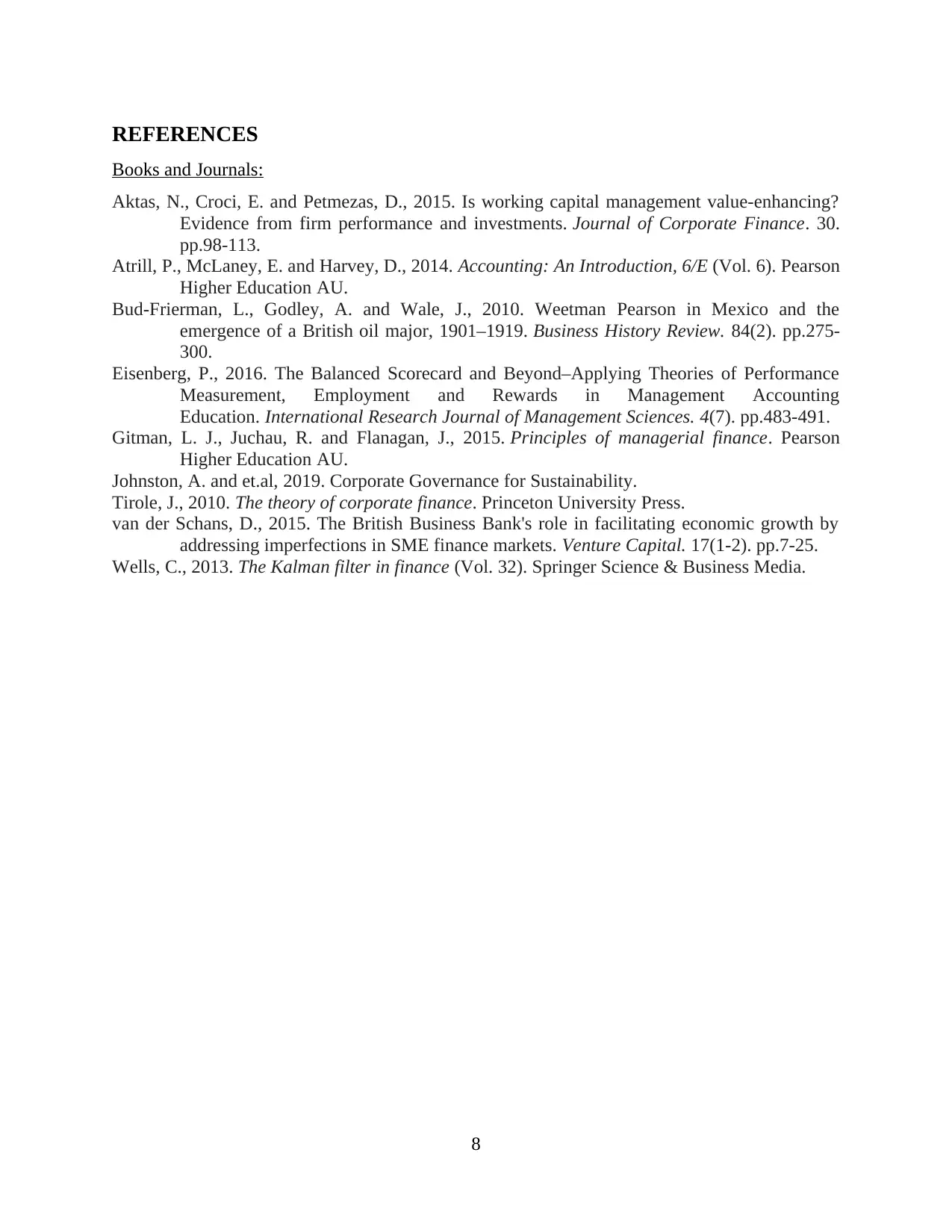
REFERENCES
Books and Journals:
Aktas, N., Croci, E. and Petmezas, D., 2015. Is working capital management value-enhancing?
Evidence from firm performance and investments. Journal of Corporate Finance. 30.
pp.98-113.
Atrill, P., McLaney, E. and Harvey, D., 2014. Accounting: An Introduction, 6/E (Vol. 6). Pearson
Higher Education AU.
Bud-Frierman, L., Godley, A. and Wale, J., 2010. Weetman Pearson in Mexico and the
emergence of a British oil major, 1901–1919. Business History Review. 84(2). pp.275-
300.
Eisenberg, P., 2016. The Balanced Scorecard and Beyond–Applying Theories of Performance
Measurement, Employment and Rewards in Management Accounting
Education. International Research Journal of Management Sciences. 4(7). pp.483-491.
Gitman, L. J., Juchau, R. and Flanagan, J., 2015. Principles of managerial finance. Pearson
Higher Education AU.
Johnston, A. and et.al, 2019. Corporate Governance for Sustainability.
Tirole, J., 2010. The theory of corporate finance. Princeton University Press.
van der Schans, D., 2015. The British Business Bank's role in facilitating economic growth by
addressing imperfections in SME finance markets. Venture Capital. 17(1-2). pp.7-25.
Wells, C., 2013. The Kalman filter in finance (Vol. 32). Springer Science & Business Media.
8
Books and Journals:
Aktas, N., Croci, E. and Petmezas, D., 2015. Is working capital management value-enhancing?
Evidence from firm performance and investments. Journal of Corporate Finance. 30.
pp.98-113.
Atrill, P., McLaney, E. and Harvey, D., 2014. Accounting: An Introduction, 6/E (Vol. 6). Pearson
Higher Education AU.
Bud-Frierman, L., Godley, A. and Wale, J., 2010. Weetman Pearson in Mexico and the
emergence of a British oil major, 1901–1919. Business History Review. 84(2). pp.275-
300.
Eisenberg, P., 2016. The Balanced Scorecard and Beyond–Applying Theories of Performance
Measurement, Employment and Rewards in Management Accounting
Education. International Research Journal of Management Sciences. 4(7). pp.483-491.
Gitman, L. J., Juchau, R. and Flanagan, J., 2015. Principles of managerial finance. Pearson
Higher Education AU.
Johnston, A. and et.al, 2019. Corporate Governance for Sustainability.
Tirole, J., 2010. The theory of corporate finance. Princeton University Press.
van der Schans, D., 2015. The British Business Bank's role in facilitating economic growth by
addressing imperfections in SME finance markets. Venture Capital. 17(1-2). pp.7-25.
Wells, C., 2013. The Kalman filter in finance (Vol. 32). Springer Science & Business Media.
8
1 out of 10
Related Documents
Your All-in-One AI-Powered Toolkit for Academic Success.
+13062052269
info@desklib.com
Available 24*7 on WhatsApp / Email
![[object Object]](/_next/static/media/star-bottom.7253800d.svg)
Unlock your academic potential
© 2024 | Zucol Services PVT LTD | All rights reserved.





